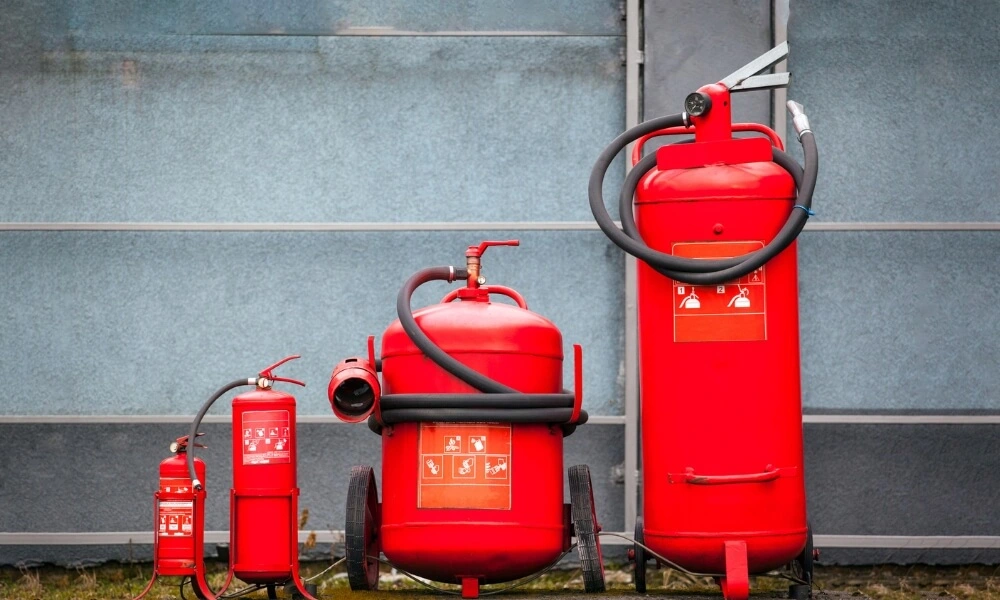Understanding the different fire extinguisher sizes and weights is crucial to ensuring preparedness in a fire emergency. These firefighting tools come in various forms, each designed for specific settings, from the comfort of your home to expansive industrial environments.
In our comprehensive blog post, we will demystify these vital devices. We’ll explore the spectrum of fire extinguishers, from the compact 2 lbs units ideal for personal use to the large, wheeled units essential for industrial applications. Each comes with its own firefighting capacities and ideal use cases, which we will discuss in detail.
This guide gives you the knowledge to make an informed decision when purchasing a fire extinguisher. After all, having the right tool at your disposal can make all the difference when protecting your property and, most importantly, your life from the threat of fire. Let’s dive in!
Different Fire Extinguisher Sizes And Weights
Fire extinguishers are integral safety devices designed to combat fires in their initial stages, to prevent a small incident from turning into a large, uncontrolled disaster. They come in various sizes and weights, each intended to fit a specific use case – from small personal devices for vehicle fires to giant wheeled units for industrial settings. Understanding these sizes and weights can help ensure you’re properly equipped to handle a fire emergency.

2 lbs Fire Extinguishers:
The smallest available, these fire extinguishers weigh around 2 lbs when empty, but with the fire-extinguishing agent inside, the total weight is typically between 5 and 6 lbs. Despite their small size, they can discharge for approximately 8 to 10 seconds, covering a range of about 5 to 8 feet.
Fire extinguishers are ideal for personal use, such as in vehicles or small kitchens. They’re designed to handle small, contained fires. This size extinguisher is typically filled with a dry chemical powder that can handle Class A (combustibles like paper or wood), B (liquids and gases), and C (electrical equipment) fires.
5 lbs Fire Extinguishers:
A 5 lbs fire extinguisher is a versatile size that’s popular for residential and small commercial applications. When fully charged with an extinguishing agent, these units typically weigh around 10 lbs. They usually have a discharge time of 10 to 15 seconds, with a range of 10 to 15 feet.
This size is often filled with ABC dry chemicals, making it suitable for a broad range of fire types. Because of its versatility and relatively lightweight, it’s a common choice for homes, small businesses, and vehicles.
10 lbs Fire Extinguishers:
These extinguishers are designed for larger residential and commercial buildings. They’re still small enough to be portable but provide a greater firefighting capability than smaller sizes. When filled, a 10 lbs fire extinguisher usually weighs 18 to 20 lbs and has a discharge time of 15 to 20 seconds, reaching 15 to 21 feet.
Like the smaller sizes, these are often filled with ABC dry chemicals, making them a practical choice for various settings. Their longer discharge time and range can make them more effective in larger areas.
20 lbs Fire Extinguishers:
Typically found in industrial or large commercial settings, these extinguishers provide a high level of fire-fighting power. When fully charged, a 20 lbs fire extinguisher can weigh between 35 and 50 lbs, with a discharge time of 20 to 25 seconds and a range of 20 to 25 feet.
These large extinguishers are often filled with either ABC dry chemical or Purple K, a special dry chemical designed for oil and gas fires.

Wheeled Fire Extinguishers:
These large, wheeled units are designed for industrial settings where high volumes of fire-extinguishing agents may be needed. They can contain between 30 and 350 lbs of extinguishing agent, which means they can weigh between 100 and 600 lbs when fully charged.
Despite their size, these units are designed to be relatively easy to move and operate by one person. The type of extinguishing agent can vary, but it’s often either ABC dry chemical, Purple K, or a foam concentrate.
Regardless of the fire extinguisher’s size or weight, the proper technique follows the PASS (Pull the pin, Aim the nozzle, Squeeze the handle, Sweep the nozzle side to side) method. Additionally, it’s important to have fire extinguishers inspected and serviced regularly to ensure they’re ready for use in an emergency.
Conclusion
To conclude, fire extinguishers’ different sizes and weights – from the personal 2 lbs units to the large, industrial wheeled versions – cater to a wide range of fire safety needs. Their size indicates their capacity, total weight, discharge time, and effective range. By understanding these variables, you can select the most appropriate extinguisher for your specific environment, whether a small car, a large residential property, or a vast industrial complex.
Keep in mind, regardless of size or weight, all fire extinguishers should be regularly maintained and used following the PASS (Pull, Aim, Squeeze, Sweep) method to ensure their effectiveness in a fire emergency.

